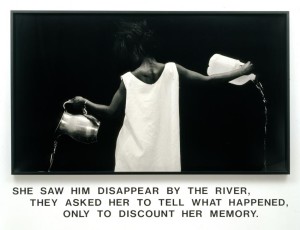to revisit old pains
Our conversation at the ICP about the practice of imposing text on photograph to produce an image – distinct from the practice of photographing – to relay a story/narrative that is non-linear and moves in liquid form through more than a single channel amplifies my understanding of embodied knowledge. Both Decarava/Hughes’s The Sweet Flypaper of Life and Shange/Kamoinge’s The Sweet Breath of Life are artistic undertakings that function through text and photograph to relay multidimensional images/narratives/stories. They attempt to render a full account of Black livelihoods via explorations of the extraordinarily mundane and familiar landscapes around which existence in kinship and individuality take form.
An image that was particularly striking to me, shown during Bradley’s presentation, was Lorna Simpson’s The Waterbearer. It reminded me of this quote, written by Ikenna Dieke in The Primordial Image: “The life of the dandelion is a pleasantly delicate life, a pure and tender life emerging out of the hallowed chrysalis of shared otherness, triumphantly asserting its distinction through the infinite vastness of idealized grassland.” Here Dieke is describing the possibilities of survival and regeneration, of the potentiality for growth even in the context of expansive and immeasurable loss/loneliness. The dandelion, in its ephemerality and natural proclivity towards constant regeneration and untamed growth is a perfect symbol for Black culture’s constant regeneration. For me, Simpson’s image evokes that sense of loneliness under which Black womanhood is constrained. The strain of the woman’s muscles against the weight of the water jugs evoke the effort of survival and resistance. The releasing of water, a seemingly effortless action in its futility is, in fact, deliberate and painstaking. We cannot see her face; but the tilt of her head, the asymmetry of her posture, are revelatory. We see her straining under the task of unburdening or releasing. We could even say she is offering a gift or a libation. A peace offering or a praise to the deities. A pacifying act through which she can attain peace.

A personal meditation on what the image evoked for me:
to revisit old pains. to invite them for a quiet coffee as the day begins. to welcome them onto the porch. to make room for hushed conversation. back and forths about what really happened. to relish in the minute details of a shared account. not to discount the memories. not to say the truth has been obliterated or was never fully captured. but to honor the small shifts that, with time, have elongated a shadow, deepened a curve, buffed or lacerated a surface. to revisit old pains. to talk as old friends would. with some disagreement or discord in point of view. to speak in terms of gentle rapprochement. to part with tender wishes, soothing reassurances. to remind that as long as we live, we can make time–in the slow-moving quiet of the morning, between beckoning stretches, strained yawns, scalding sips of coffee–to recollect, to recount.


Comments ( 2 )